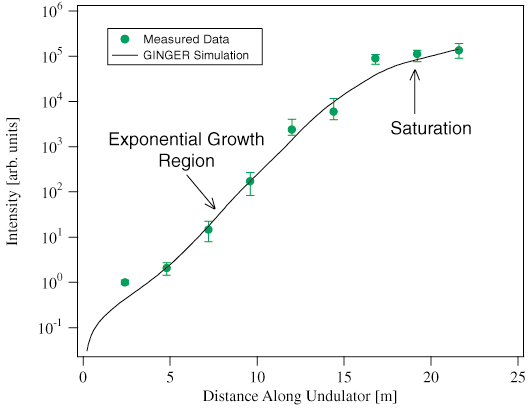The Advanced Photon Source (APS) low-energy undulator test line (LEUTL) has achieved "saturation" of self-amplified spontaneous emission in a mirrorless free-electron laser at a wavelength over 1000 times shorter than the previous record. This important accomplishment demonstrated that such free-electron lasers based on this process may one day provide laser-quality x-ray beams and possibly open exciting new horizons for research in dozens of scientific fields.
The beam of light produced in the experiment had a wavelength of 385 nanometers, placing it in the ultraviolet region of the spectrum. The success of the particular process employed the APS is gauged by whether the free-electron laser effect has "saturated," meaning the point at which the maximum power has been yielded by the electron beam and converted to coherent synchrotron radiation. The APS device clearly exhibited saturation of the process.
The next generation of x-ray sources for scientific research will be based on the free-electron laser concept, the latest extension and refinement of synchrotron radiation. Unlike a more conventional laser the APS free-electron laser uses a powerful electron accelerator in combination with long arrays of very precise magnets of alternating polarity and needs no mirrors for operation. A further significant feature of this free-electron laser is that by merely changing the electron beam energy it is continuously tunable over a broad range of wavelengths thus breaking additional barriers to traditional lasers.
Today, x-rays are the most widely used scientific probe for studying the structures and interactions of crystalline materials at the atomic and molecular levels. But many materials do not form crystals, and many reactions take place too quickly to study adequately, even at the APS. With further development, free-electron lasers of this sort promise to provide extremely bright, laser-like x-ray beams with ultrashort pulse durations that will enable scientists to study the properties and structures of materials in far greater detail and in far less time than is possible today.
As presently configured the Advanced Photon Source free-electron laser should be capable of reaching wavelengths as low as 60 nanometers with the primary limitation being the energy of the linear accelerator. To reach x-ray wavelengths one needs electron beam energies comparable to what can be produced by the world's largest linear accelerator located at the Stanford Linear Accelerator Center (SLAC). However, to capitalize on this national resource a host of additional technical challenges must still be solved.
Argonne is one of six U.S. research organizations collaborating on developing the free-electron laser technology needed to achieve this national goal of an x-ray free-electron laser. Others in the collaboration include the Stanford Linear Accelerator Center (SLAC), the University of California at Los Angeles, and Brookhaven, Los Alamos, and Lawrence Livermore national laboratories. Their collaboration is aimed at demonstrating the feasibility of the proposed Linac Coherent Light Source, a proof-of-principle fourth-generation X-ray light source to be built at SLAC.
Early publication online at Sciencexpress: http://science.sciencemag.org/content/early/2001/05/17/science.1059955
For more information, contact S. V. Milton at [email protected]

